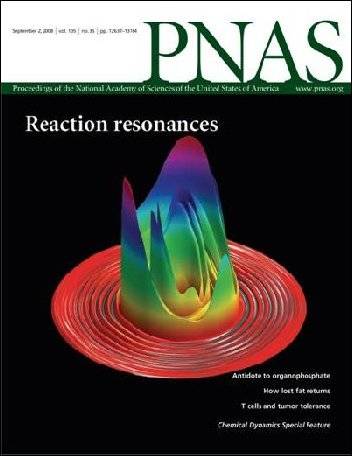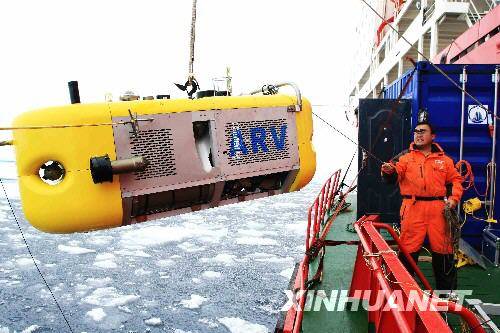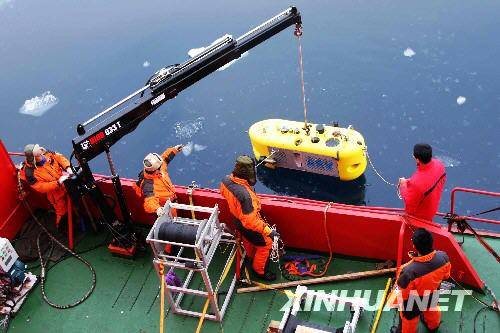|
CHINA SCIENCE AND TECHNOLOGY
NEWSLETTER
The Ministry of Science and Technology
People's Republic of China
|
|
|
N0.522 |
September 10,2008 |
|
|
|
|
|
|
|
|
IN THIS ISSUE
|
|
* Revised By-laws on National Lab Management
* More Progresses for Reaction Dynamics
* Rice Without Longevity Gene
* Wide Spectrum Life Detector
* Piglets with Swine Fever Resistance
*Sheep with Hepatocyte Growth Factor
|
Revised By-laws on National Lab Management
To further regulate and strengthen the development and management of national key labs, the Chinese Ministry of Science and Technology and Ministry of Finance have jointly revised the old by-laws on national key lab management, based on the implementation of the national key lab program, and published on August 29, 2008 the Methods on National Key Lab Operation and Management. The following are the updates: 1) establish earmarks for open operation, scientific instruments upgrading, and proprietary innovations at the national key labs; 2) define the procedures, requirements, and methodology for screening research topics, selecting visiting scholars, upgrading scientific instruments, and proprietary development, in line with the scope supported by the earmarks; 3) set up the principle and corresponding measures for the construction, operation, and development of national key labs, namely “steady support, dynamic readjustment, and evaluation on a regular basis”; 4) further strengthen the daily management, especially annual plan and summary, and random check, and establish a pre-warning mechanism for the management; 5) further solidify the terms of reference of the academic committee, allowing it playing a proper role; 6) further beef up the responsibility of sponsoring agencies, stipulating that the sponsoring agency shall give a priority support to the development of national key labs. The new management by-law also emphasizes the importance of equipment sharing, data sharing, popular science diffusion, findings spin-off, and collaboration with industry.
More Progresses for Reaction Dynamics

The State Key Laboratory of Molecular Reaction Dynamics, a part of CAS Dalian Institute of Chemical Physics, has recently achieved major progresses in molecular reaction dynamics. The findings, reported by YANG Xueming, ZHANG Donghui et al, have been published as a cover story in the recent issue of the Proceedings of the National Academy of Sciences.
In the past years, YANG Xueming and ZHANG Donghui, in collaboration with others, have worked on high accuracy experimental and theoretical study of F+HD reactions. The study team led by YANG has obtained for the first time the resonance-mediated F + HD → HF + D reaction picture at the full quantum state resolved level, using a new device developed by themselves. They also observed the drastic changes of the reaction in a range of 0.3 kcal/mol. The effort has led to the dynamic study of the reaction resonances at an unprecedented accuracy level (several cm-1), which provides precious basic experimental data for the future high accuracy theoretical study in the area.
Theoretical analyses suggest that the full-dimensional FH2 ground potential surface, jointly built by ZHANG Donghui, in collaboration with XIE Daiqian of Nanjing University, which was believed to be accurate in describing the resonance picture of the F + H2 reaction, is found to be insufficiently accurate in predicting quantitatively the resonance picture for the F + HD → HF + D reaction. To address the problem, ZHANG, working with XU Xi at Xiamen University, constructed a global potential energy surface that could predict the correct resonance peak positions as well as the dynamics for both F + H2 and F + HD, providing an accurate resonance potential for this benchmark system with spectroscopic accuracy.
Rice Without Longevity Gene
A study team, led by ZHANG Qifa, a CAS academician at Huazhong Agriculture University, has cloned a gene able to inhibit the longevity of rice, using the mutant marker separation technique. The gene allows rice to go from the vegetative phase to reproductive phase. Without the gene, rice would keep growing leaves and stalk without flowering and fruiting. A paper on the new gene, or RID1 (Rice Indeterminate), was published in the recent issue of the Proceedings of the National Academy of Sciences.
Study results show that the Rice Indeterminate 1 (RID1) gene acts as the master switch for the transition from the vegetative to reproductive phase. RID1 encodes a Cys-2/His-2-type zinc finger transcription factor that does not have an ortholog in Arabidopsis spp. This mutation-suppressed expression of the genes is known to be involved in flowering regulation. RID1 seems to be independent of the circadian clock. A model was proposed to place RID1 in the molecular pathways of flowering regulation in rice. Once the phase transition is induced with the activation of RID1, flowering signal is transduced and regulated through the various pathways, and eventually integrated with FT-like proteins to induce flowering.
ZHANG said that the separation of RID1 is of theoretical importance to understanding the plant flowering mechanism and regulating the timing and nature of flowering at the molecular level. The study also deepens people’s understanding of the flowering mechanisms of monocotyledonous and dicotyledonous plants. Furthermore, flowering time determines the seasonal and regional adaptability of rice, which in turn affects the rice yield. The finding can be used to improve the regional adaptability of rice, raising the yield. It can also be used to improve other species, such as Platanus Orientalis L. a tree never flowers, and grazing grasses that have a delayed flowering.
Wide Spectrum Life Detector
Thanks to the decade long painstaking efforts, Prof. WANG Jianqi at the Dept. of Biomedical Engineering, part of the No. 4 Military Medical School, and coworkers have recently developed a wide spectrum life detector that can be applied extensively in rescue activities. The development has made China another country after the United States able to develop the instrument.
Since 1998, Prof. WANG and his team have made a systematic study of detecting radar technologies at different wave lengths. They developed a range of technologies to address the key requirements of the system, including noise signal suppression and moving target interference. The offsetting technologies such as positioned noise signal suppression, has effectively inhibited the interference of moving targets. They also worked out the solutions to collecting weak life signals, based on their improved understanding of human breathing and heartbeat, making the detector more sensitive and accurate.
The field test of the instrument in the Wenchuan Earthquake has shown that it is able to penetrate rubbles as deep as 9m, feeling the breath of a static person, and presenting the information on the distance of targets. It played a key role in finding the earthquake survivors at a primary school in Qushan.
Piglets with Swine Fever Resistance

Jilin University announced on September 10, 2008 that it has successfully had the birth of three piglets carrying anti-swine fever genes on September 9. The event marks the success of the first attempt of cloning a pig with anti-swine fever gene in the world. The three piglets, weighing 1050g, 1100g, and 550g respectively, have been healthy and well after the birth.
It takes two-year efforts for the study team, headed by Prof. LAI Liangxue of Jilin University and coworkers at the No. 11 Institute under the Chinese Academy of Military Medical Sciences, to transfer the genes that are able to inhibit swine fever viruses into fetal fibroblasts, before becoming a cloning fetus for further conceiving in a Duroc sow. The sow gave birth to three healthy piglets after 114 days of pregnancy. Tests have shown that the piglets have carried the genes able to inhibit swine fever viruses.
Sheep with Hepatocyte Growth Factor
Two special black goats have survived for nearly 5 months at the Xinjiang Academy of Agricultural Sciences. The goats, the first instance cloned to carry hepatocyte growth factors in the country, were born on April 19 and 22, 2008 respectively. Comparing with the prevailing technologies used for the purpose, the new technology attempts to infuse the genes able to enhance hepatocyte growth into the donor cells. As a result, one may extracthepatocyte growth factors from goat milk for treating liver diseases, enhancing the growth of hepatocyte, and improving the functions of liver cells. The new technology will eventually lead to more goats carrying the genes, creating a valuable approach for treating liver patients.
Chinese Submarine Robot Works at High Latitudes


The Chinese made submarine robot, Beiji-ARV has recently completed its under-ice investigation across an Arctic Ocean area at 84°north latitude, the first of its try at such a high latitude. Beiji-ARV, jointly developed by CAS Shenyang Institute of Automation and others, is a proprietary marine environment monitoring system able to work on its own, or operate through remote control. In the under-ice investigation, it collected an array of observational data on ice floor forms and sea ice thickness using its on-board equipment, including temperature-salinity sounder, supercrop sonar, luminous flux meter, and submarine camera. It also conducted observation of the physical, hydrological, and optic properties of sea ice over the Arctic Ocean area in a simultaneous manner.
Satellites for Environmental Disasters
At 11:25 September 6, 2008, China launched two microsatellites from the Taiyuan Satellite Launch Center, to monitor environment and related disasters. 51 minutes after the launch, the satellites were separated from the carrier rocket, before entering the solar synchronous orbit. The two microsatellites are two optic devices carrying two wide-area multi-spectrum camera, and one super spectrum imager on satellite A, and two wide-area multi-spectrum cameras and one infrared camera on satellite B. With a designed work life for three years, both microsatellites will work in the same orbit circling the earth in 98 minutes, at a preset interval of 49 minutes. The two satellites will work together to make a global coverage once every two days.
According to a briefing, the China Center for Resource Satellite Data and Applications (CRESDA) and CAS Satellite Ground Station have jointly built a ground receiving for the purpose. The former will be responsible for handling the data, and delivering the processed data to users, while the latter will take care of receiving, archiving, and disseminating the downlink data.
Research Center for Magnetically Confined Plasma Physics
The Chinese Academy of Sciences inaugurated on September 2, 2008 the opening of a theoretical research center for magnetically confined plasma physics. LI Ding, head of the CAS Bureau of Basic Research, and LIU Quansheng, a renowned professor at the University of Maryland, and honorable director of the new center were present at the ceremony. Scientists from an array of overseas research institutes, including the Princeton Plasma Physics Lab, GE Institute of Atomic Fusion, Lawrence Livermore National Laboratory, and the Max Planck Institute for Plasma Physics, also made their presence at the event. The Center is established to study and develop nuclear fusion technology in China, improve the advanced Tokamak operation model, enhance the capacity building of experimental and commercial fusion facilities, and tap up more potentials from the EAST for more world class findings.
DC Reactor with Highest Voltage
Not long ago, a ±800 kV dry DC reactor, developed by TBEA, passed its verification check. According to a briefing, the DC reactor that has passed the required test on June 5, 2008 at TBEA, is designed for the world first ±800kV DC power transmission line running from Yunnan to Guangdong built by South China Power Grid, with an internationally advanced technical level. The product is a new asset to TBEA’s world class products portfolio, or 23 in total.
Vertical Winding Machine with Largest Capacity
A proprietary large vertical winding machine with the largest bearing capacity, developed by Tianwei Zuochuang Electric Equipment in Baoding, has recently put into official operation. The new product, or VW-40, enjoys numerous merits, including large output torque, enhanced bearing capacity, raised overall strength, simple structure, smooth and reliable operation, standardized modules, and fine synchronous transmission. Application of new technologies, such as frequency converter, PLC module, and touch-screen, has made the machine highly automatic, with a simplified and standardized operation. Meanwhile, it has cut down the number of failure spots and I/Os needed by PLC, effectively streamlined the overall structure, and made the machine more up to the technical requirements for winding. Its beautiful exterior and interactive design allows a more comfortable operation.
Comments or inquiries on editorial matters or Newsletter content should be directed to:
Mr. XU Chaoqian, Department of International Cooperation, MOST 15B, Fuxing Road, Beijing 100862, PR China Tel: (8610)58881360 Fax: (8610) 58881364
http://www.most.gov.cn |

